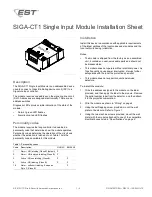
© 2013 UTC Fire & Security Americas Corporation, Inc.
1 / 4
P/N 387021P-
EN • REV 12 • ISS 23JUL13
SIGA-CT1 Single Input Module Installation Sheet
Description
The SIGA-CT1 Single Input Module is an addressable device
used to connect a Class B initiating device circuit (IDC) to a
Signature loop controller.
The module requires one address on the signaling line circuit
(SLC). Addresses are assigned electronically. There are no
address switches.
Diagnostic LEDs provide visible indication of the state of the
module:
•
Normal: green LED flashes
•
Alarm/active: red LED flashes
Personality codes
The module requires the loop controller to download a
personality code that determines how the module operates.
Personality codes determine the operation of the circuit and
whether the activation is latched or not. Table 1 lists the
personality codes available for
this module.
Table 1: Personality codes
Code Description
UL/ULC EN 54-18
1
Alarm –
NO latching (Class B) (default)
P
2
Alarm – NO delayed latching (Class B)
P
3
Active - NO nonlatching (Class B)
P
P
4
Active - NO latching (Class B)
P
P
18
Alarm -
soft short latching, European
Style C (Class B)
P
Installation
Install this device in accordance with applicable requirements
of the latest editions of the local codes and standards and the
local authority having jurisdiction.
Notes
•
The module
is shipped from the factory as an assembled
unit; it contains no user-serviceable parts and should not
be disassembled.
•
This module does not operate without electrical power. As
fires frequently cause power interruption, discuss further
safeguards with the local fire protection specialist.
•
This module does not support conventional smoke
detectors.
To install the module:
1. Write the address assigned to the module on the label
provided, and then apply the label to the module.
Remove
the serial number label from the detector, and then attach
it to the project documentation.
2. Wire the module as shown in “Wiring” on page 2.
3.
Using the self
-tapping screw provided, mount the wall
plate to the module.
Refer to
Figure 1.
4. Using the two machine screws provided, mount the wall
plate (with the module attached) to one of the compa
tible
electrical boxes listed in “
Specifications
” on page 2.





















